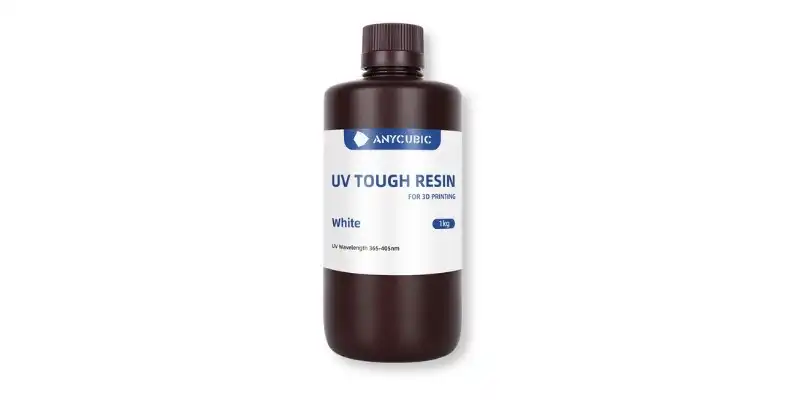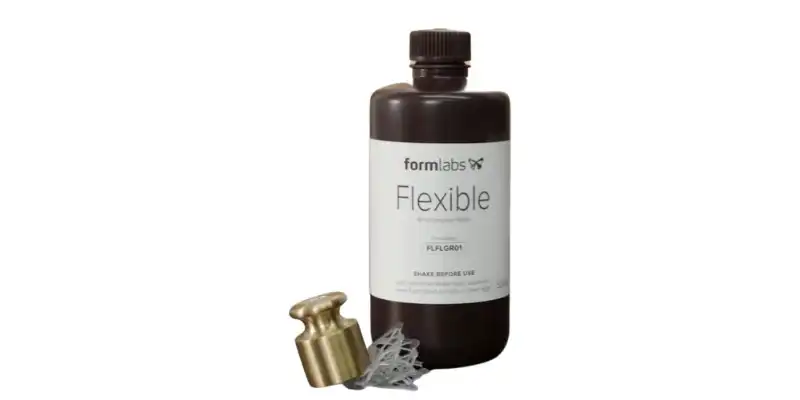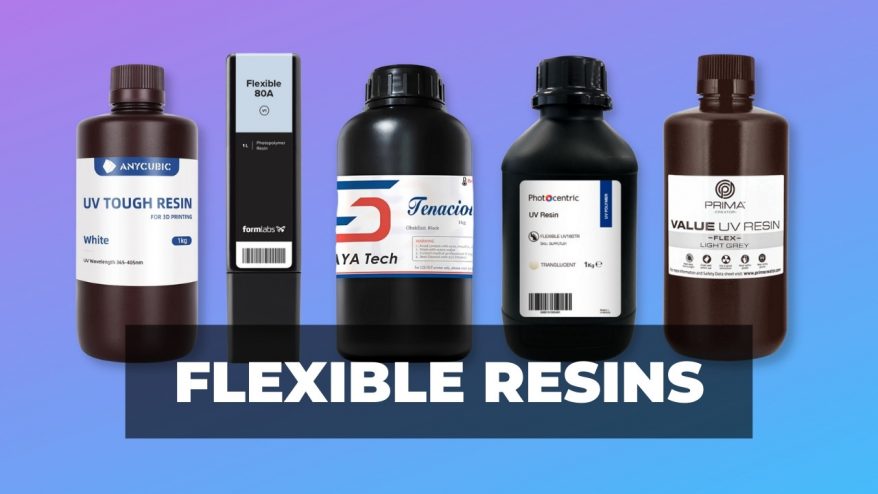
3D printer resins are normally used for decorative pieces. Once cured, they’re often quite hard and sturdy, making them ideal for decorative pieces and board game additions.
But that doesn’t mean different resin types can’t have different properties. Some are brittle, some are reinforced, and some are flexible resins.
|
|
|
|
$60/kg
|
$204/L
|
|
|
|
Flexible resins (sometimes misspelled as ‘flexable resins’) are resins that you can bend and press easily even after curing. This unique attribute gives them a variety of uses outside of simple decorations.
Here we’re going to look at the best flexible resins and brands, how they work, what you can use them for, and the best places to get them.
What is Flexible Resin?
A standard resin’s firmness comes down to its Shore hardness, which is basically a measure of a particular material’s elasticity. The lower the shore hardness, the more flexible the resin.
Before the advent of flexible resins, you would have had to turn to FDM printing, specifically TPU filament, for the best chance of a tough yet flexible 3D print.
In the last five years, flexible resins have been more popular and better compounded, meaning we now have a good selection of flexible resins today.
Shore Hardness and Flexible Resins: A Brief Overview
Shore 00 usually refers to softer materials like hair gels and elastic, Shore D is the other end of the scale, measuring hard rubbers like shoe heels and car tires through harder plastics like those used to make hard hats.
Shore A is the middle of the scale, overlapping the upper end of Shore 00 hardness (comparable to a standard eraser) and the lower end of Shore D (vehicle tire treads).
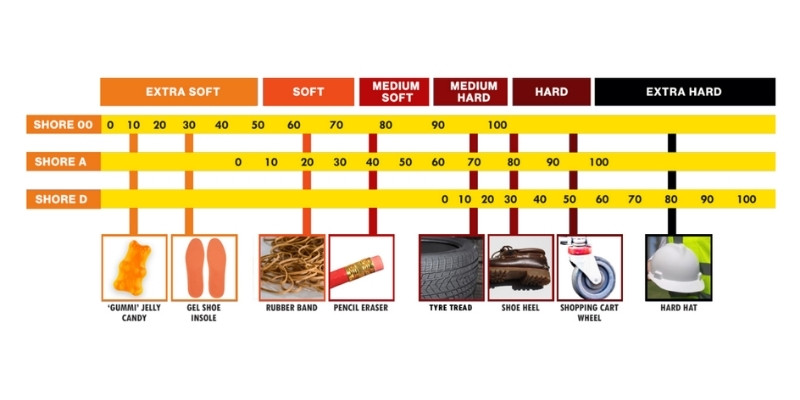
Where a particular flexible resin falls on this scale differs between manufacturers. Typically, flexible resins are on the higher end of Shore A (lower end of Shore D). Siraya Tech’s flexible resin, for example, is Shore D 65, meaning it’s about as hard as a standard shopping cart wheel.
This means you should expect your flexible resin to have the consistency of a pencil eraser, a car tire, or – at its hardest – a rubber shoe heel. This impact resistance makes flexible resins quite durable, as they will ‘bounce’ on impact rather than break.
Are Flexible Resins Like Rubber?
Standard 3D printing resins have a relatively high shore hardness, meaning they’re rigid and will break before they bend. Flexible resin, on the other hand, is much lower on the Shore scale, making it easy to bend without losing much, if any, sturdiness or strength.
It’s important to note that flexible does not mean stretchy, it simply means prints can be temporarily manipulated and are generally impact-resistant.
So you won’t be able to 3D print a stress ball with flexible resins by just making a sphere, for example, you’ll need to print a meshed orb to get that fully squashable feel.
While flexible resins do have a sort of elasticity to them, the hardest of even flexible resins won’t ‘squish’ in your hands, as it were, and so are closer to the flexibility you’d expect from hard rubber than from a rubber band.
This distinction is important to note if you’ve got your heart set on making something softer than, say, a watch strap.
Is Flexible Resin Safe?
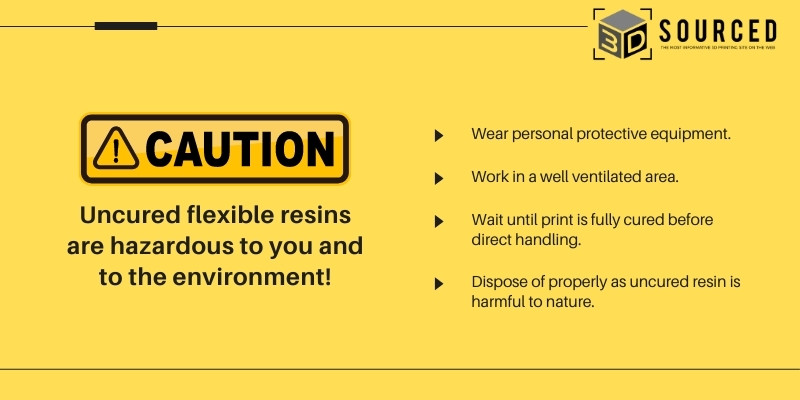
Flexible resins don’t pose any more dangers than your standard 3D printing resins. This means you’ll be perfectly fine as long as you follow standard safety precautions when 3D printing.
Always be sure that the uncured resin doesn’t come in direct contact with your skin or eyes by wearing protective gloves. Ensuring good ventilation in your workspace while printing will help you avoid breathing potentially toxic fumes.
Always make sure your flexible resin is fully cured before touching it directly, and always follow the safety instructions given to you by your chosen manufacturer.
Environmentally speaking, flexible resins are hazardous to marine life, so never dispose of leftover resins in standard plumbing. To properly throw out your flexible resin, be sure to fully cure it and any liquids you’ve washed it in before throwing it out with your usual plastic waste.
How to 3D Print with Flexible Resins
Flexible resins are harder to use than your standard UV resins. Due to their elasticity, flexible resins are more finicky compared to your usual resin printing affair, and are harder to pry from your build plate.
Think of it this way: a well inflated basketball is a lot easier to hold steady than a filled water balloon. And it’s the unsteadiness that comes with bendiness that means you’ll need to change up your usual printing routine when using flexible resins.
While the recommended printer settings will change depending on your chosen manufacturer and your 3D printer, you may need to do a little trial and error yourself to get the best results for you.
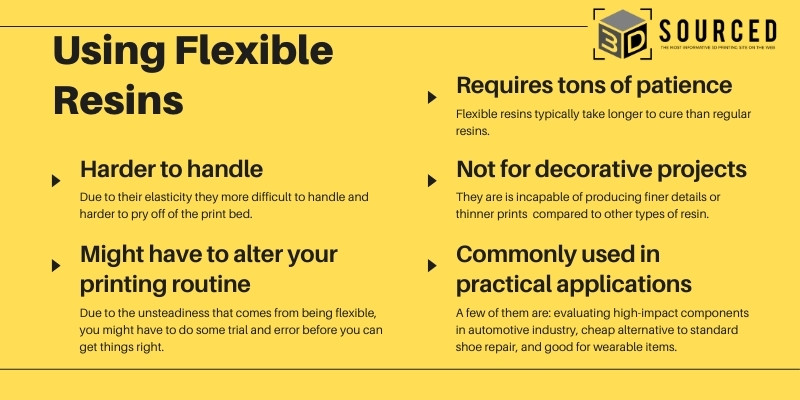
In general, flexible resins have longer curing times than standard resins, so being a little more patient will go a long way when using these materials.
The main thing to keep in mind is that, like rubber, flexible resins will go back to their initial shape if bent out of it.
Have you ever scrunched up a rubber band and dropped it on the table? If so, you’ll know that it finds a way back to its usual circular shape. Because of this, you need to be sure to have your design be the exact shape you want it to stay once printed.
Flexibility may bring thoughts of string or leather belts, which will normally sit and stay in whatever shape you’ve left them in, but that’s not the case for flexible resins.
While flexible properties have practical uses, you’ll want to make sure your print doesn’t become unusable because it keeps trying to revert to the wrong shape.
What are Flexible 3D Prints Used For?
Unlike other resins, flexible resins aren’t very good for decorative applications. They aren’t as capable of finer details or thinner prints as normal resins, and so are mainly used for practical applications.
This makes them very useful compared to standard resins, and are highly sought after as a result.
The most common application is prototyping. Flexible resin’s durability makes it ideal for testing high-impact parts needed in vehicle repair and maintenance.
On the less mechanical side, flexible resins are great for cobbling as well. Rubber shoe soles need to withstand frequent weight and impact without losing durability or cracking, making flexible resins invaluable as cheap alternatives to standard shoe repair.
Flexible resins are also excellent for wearable items like scuba goggles, which need to be strong enough to be watertight, but comfortable enough to be worn.
With all of this in mind, let’s take a look at some of the best places to buy flexible resins and why they’re ideal.
Best Flexible Resins
3DSourced is reader-supported. When you buy through links on our site, we may earn an affiliate commission. Learn more
Anycubic Flexible Tough Resin
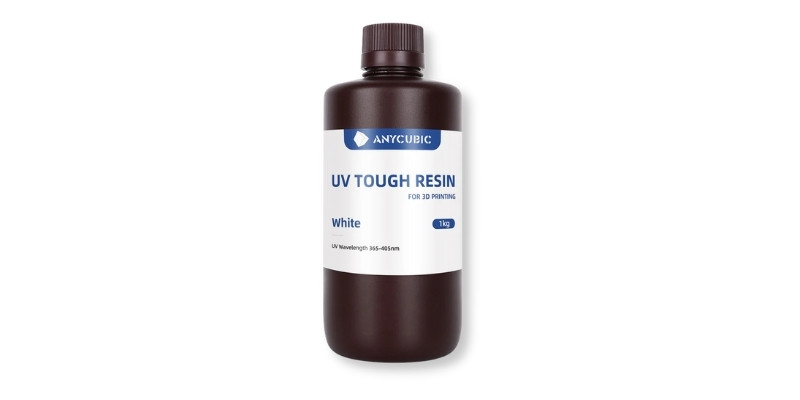
- Price: $60/kg – Available at Anycubic here / Available at Amazon here
- Wavelength: 365 – 405nm
- Shore Hardness: Shore D 76
- Available Colors: White, Black, Gray, Clear, and Translucent Green
Pros
High tensile strength and enhanced durability.
Low shrinkage and high accuracy.
Can handle mechanical pressure, making it great for moving projects like clocks.
Lots of color variants are available.
Cons
No major drawbacks.
As its name suggests, Anycubic’s flexible tough resin prides itself on flexibility that won’t break while bending. With high tensile strength and enhanced durability, it’s a top choice for those of you who want to make reliable parts that literally won’t crack under pressure.
Along with this robustness comes Anycubic’s promise that it’s just as high-quality as their other resins. With low shrinkage and high accuracy, this is a flexible resin ideal for model and mechanical parts that need to withstand repeated impacts like mechanical parts and wearable items.
It can also handle mechanical pressure, making it great for parts in moving projects like clocks. However, its relatively high Shore hardness does mean that it’s not ideal for more bendable projects like watch straps or belts.
As a flexible resin, it’s capable of the same kind of detailing as standard resins or Anycubic’s own Resin+, but its rigidity and flexibility combine to make a sturdy resin that’s ideal for more practical applications than decorative ones.
Anycubic also has a better color selection for its flexible resin than most other manufacturers, which is good news if you don’t like being restricted to dull or dark colors.
Anycubic offers one of the strongest flexible resins on this list, ideal for professionals who need to make or prototype good, reliable parts that need to withstand constant impact. It’s also one of the cheapest flexible resins available, which is great for those of you on a budget who don’t mind their flexible resins being a little harder than most.
- Read more: Anycubic vs Elegoo resins
Formlabs Flexible and Elastic Resins
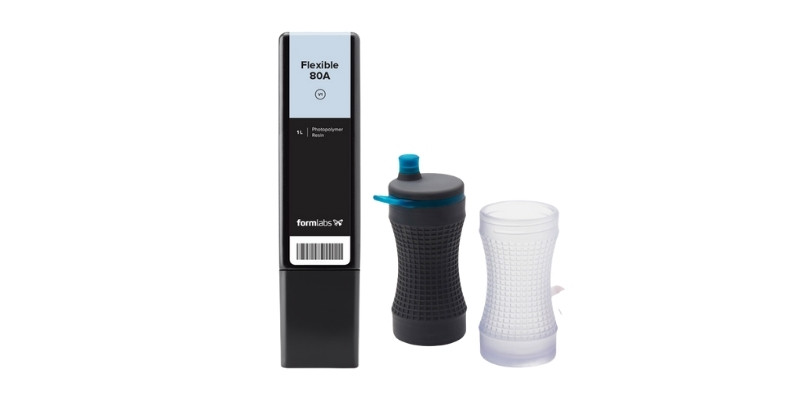
- Price: $204/L – Available at Dynamism here
- Shore Hardness: Shore A 80
- Available Colors: Clear Only
Pros
Designed for professional applications.
Formlabs offer an elastic resin if you’re looking for something more bendable.
Cons
Pretty expensive.
Formlabs’ flexible resin might be on the more expensive end of the scale, but it’s definitely designed for professional applications. Water-tight masks and parts will be able to take advantage of its lower Shore hardness when compared to Anycubic, making it softer and more malleable.
That’s not to say it will squish, however, as a Shore A 80 hardness means it’s roughly as rigid as a rubber shoe heel. While this is ideal for standard prototyping and part repairs, it doesn’t have the same impact resistance as something in the D range.
If you’re looking for something more bendable, though, Formlabs also offers an elastic resin, with a Shore hardness of 50 A, making it only slightly harder than a standard pencil eraser.
While ‘elastic’ is a bit of a misnomer, it may still prove useful to those of you looking for something a little softer than most flexible resins on the market.
Siraya Tech Tenacious Flexible Resin
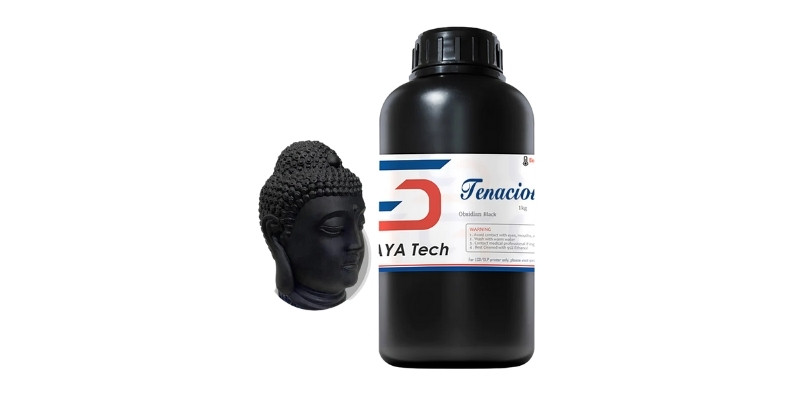
- Price: Check price on Amazon here
- Wavelength: 405nm
- Recommended Printer Temperature: 25℃ at least
- Shore Hardness: Shore D 65
- Available Colors: Clear and Obsidian Black
Pros
Balances tensile strength and flexibility quite impressively.
Bendable up to 180 degrees without breaking.
The clear version is easy to dye.
Cons
Color selection is lacking.
Siraya Tech’s boldly named Tenacious flexible resin is a resin that balances tensile strength and flexibility quite impressively, especially at such a low price.
While most flexible resins aren’t designed for thinner parts and projects, Siraya Tech’s Tenacious resin lives up to its name by being both flexible and tough. Bendable up to 180 degrees without breaking, this flexible resin is perfect for fasteners like watch straps and belts.
Its post-cure Shore hardness shows it to be just harder than a shopping cart wheel, which puts it somewhere between the relatively soft Formlabs flexible resin, and Anycubic’s flexible tough resin. So if you found Anycubic to be too tough and Formlabs too soft, then Siraya Tech’s Tenacious resin should be just right.
While the color selection may be lacking, the clear version is quite easy to dye. So don’t be discouraged if you’re set on the Tenacious resin but would rather have more hues to choose from.
Photocentric Flexible UV160TR
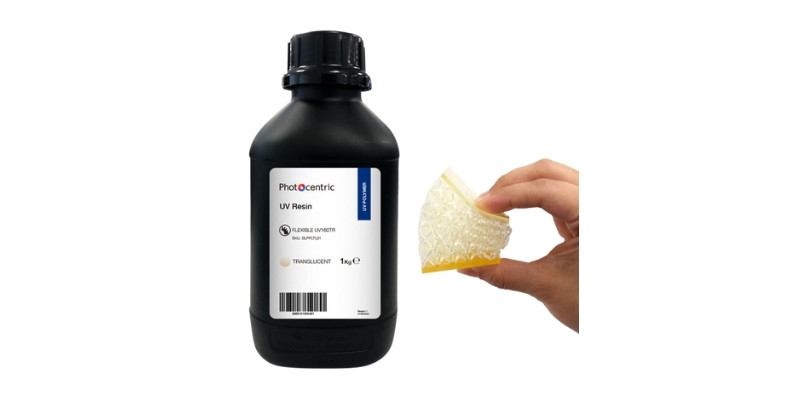
- Price: $80/L – Available at Matterhackers here
- Shore Hardness: Shore A 86
- Available Colors: Clear Only
Pros
Highly compatible with most resin printers.
Can be rotated 200 degrees before breaking.
Not too soft and not too hard.
Cons
Does not react well to alcohol solutions for clean up.
Photocentric’s flexible resin may not have a flashy name like all the others, but it doesn’t really need one. This easily-dyed flexible resin is highly compatible with most resin printers and offers impressive elasticity and tensile strength.
Ideal for things like shoe repair and handlebar grips, it’s sturdy enough to withstand high impacts and frequent movement while being tougher than many others.
For example, Photocentric can be rotated up to around 200 degrees before breaking, making it stronger than Siraya Tech, albeit more expensive.
For a flexible resin, its Shore hardness is fairly average, meaning it’s not so soft that it would be unreliable in mechanical parts, but not so hard that it’s difficult to work with.
When it comes to post-processing, however, it is a little more finicky. If you normally use alcohol solutions to clean up your resin prints, you’ll be disappointed to hear that Photocentric’s flexible resin does not react well to this with some users reporting it ‘melting’.
To be safe, wash it with clean warm water instead. Normally, this wouldn’t be ideal for high-resolution resin prints, but it’s not too much of a downside here as flexible resins aren’t generally capable of the resolution standard prints are anyway.
If you’re a professional who wants to ensure thorough research before adding to your cart, then you’ll be happy to know that all details of the well-tested UV160TR flexible resin are available in this PDF.
PrimaCreator Flexible Resin
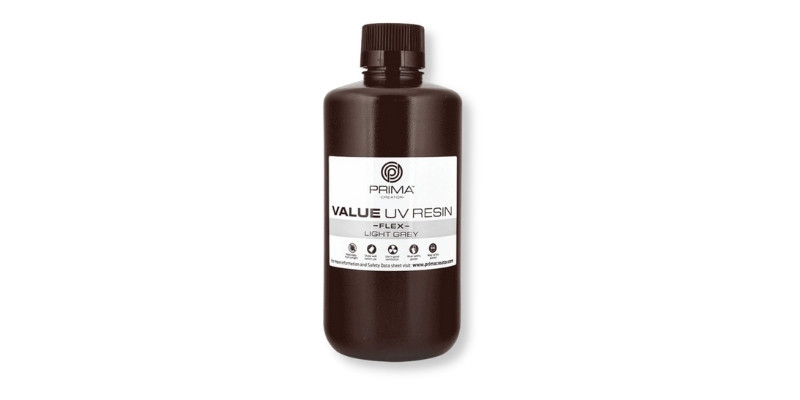
- Price: ~$90/kg – Available at Prusa store here
- Shore Hardness: Shore D 65
- Available Colors: Clear Only
Pros
Ideal for beginners due to its easy printability and no-nonsense post-processing.
Robust tensile strength and easy usability.
Highly impact-resistant and fast-curing.
Cons
PrimaCreator is quite upfront about the fact its resin’s solution is significantly worse than those of standard UV resins.
Available from trusted 3D printing provider Prusa, PrimaCreator flexible resin is ideal for beginners due to its easy printability and no-nonsense post-processing.
Unlike many other manufacturers, PrimaCreator is quite upfront about the fact that its flexible resin’s resolution is significantly worse than those of standard UV resins. It makes up for this with robust tensile strength and easy usability.
Post-processing with standard alcohol solutions won’t ruin prints made from this flexible resin like it would with Photocentric’s brand. This means you won’t need to take any extra or special precautions than you would with normal resin printing.
It’s quite hard for a flexible resin, and isn’t as durable as other brands, but it’s still highly impact-resistant and fast-curing. While still highly compatible, it’s designed to be used best with Prusa resin printers, so it’s mainly for those of you with brand loyalty, or who just already happen to own – or are already interested in purchasing – a Prusa printer.
Related Posts:
